Repeat Acute Recoverability to Full-Body Resistance Training Among Highly Trained Individuals.
By: Benjamin T House , Ryan L’Ecuyer , Michael T. Nelson , and Thomas R. Wood
Abstract: Findings of recoverability to resistance training are variable based on training status, compound vs. single joint exercises, number of sets, and proximity to failure. It is currently unknown whether highly trained males can recover from repeated full-body training within 24 hours. Thirteen highly trained males with an average 10 rep max (RM) bench press of 1.03 times bodyweight performed a full-body training protocol consisting of two sets of 11 exercises to a 9 or 9.5 RPE on four consecutive days. Recovery was measured via the perceived recovery scale (PRS) and performance fatigue was measured daily before the commencement of training via average concentric velocity (ACV) of a single repetition for both the bench press and the squat at the subject’s 10RM weight. Repetition performance and ACV were not significantly reduced across the four days. PRS decreased significantly by day 3 (p=0.001) and then increased slightly on day 4 compared to day 3, but remained significantly lower than day 1 (p=0.03). On the final day of training, mean squat repetitions increased significantly compared to day 3 (p<0.0001), with seven of nine remaining athletes increasing performance by two total repetitions. In highly trained individuals, a significant decrease in perceived recovery, but no significant decrease in total rep performance or ACV for the bench press or the squat was seen across four consecutive days of full-body training at an RPE of 9-9.5. Thus, for highly trained individuals, resistance-training performance may be maintained over four consecutive days of moderate volume full-body training at an RPE of 9-9.5, with decrements in perceived recovery not predictive of acute performance.
Keywords: Recoverability; Muscle; Lean Body Mass; Resistance Training
1. Introduction
Individual recoverability to resistance training is highly variable among subjects [1-7] as well as differing in response to different exercises (compound vs. single joint and upper body vs. lower body) [2,8]. An athlete’s speed of recovery also has the potential to regulate chronic hypertrophic adaptations by determining training volume and frequency. Increasing the number of sets [4] and training to failure [4,9-11] both tend to increase required recovery times.
However, in trained subjects utilizing two to four sets per exercise performed to failure, some individuals are fully recovered within 48 hours [1,2,5]. Recent studies in even more highly trained males have found that these subjects may be able to recover from 8 to 10 sets of pressing to failure within 48 hours [12,13]. As total volume is a determinant of long-term hypertrophy, the hypertrophic adaptations to a chronically high training volume may be increased in those who recover faster compared to those subjects who do not due to an ability to increase productive training frequency and volume, which have both been related to increased hypertrophic adaptations [14,15].
High-frequency full-body training for hypertrophy seems to be growing in popularity, yet research to date on this exact approach is limited [16]. Training each muscle group two to three times per week looks to outperform once per week for hypertrophy [17]. Training volume also looks to be somewhat linearly related to muscle hypertrophy, especially in more trained populations [15,18-20], and distributing volume over more days may allow for further increases in training volume in highly trained individuals.
Additionally, there may be a cap on productive training volume per session [21,22]; thus, lower training frequencies would theoretically lower the amount of productive training that could be performed in the week. Training frequency may not have as much of an independent effect on strength [23], but again increased training frequency may allow for more volume per week or a more equal distribution of volume which may increase strength gains [24]. Yet, it is currently unknown if highly trained subjects can recover from full-body training sessions in 24 hours when sets are not taken to momentary muscular failure and if they can, can they do so repeatedly while maintaining or even increasing performance across four sequential training sessions.
In the current study design, 4 sets per muscle group per session were performed [25]; at 5 sessions per week this would result in a total training volume of 20 working sets per week per muscle group. The objective of this study was to investigate the recoverability and performance fatigue of highly trained males performing four sets per muscle group at a 9 or 9.5 (RPE) every day over four consecutive days.
2. Materials and Methods
Subjects were recruited through direct email and social media. The final sample included 13 highly trained males (Table 1), although two subjects did not complete the last day of training due to scheduling conflicts. Additionally, two subjects were not able to squat to a 9 or 9.5 RPE due to previous injuries. Informed written consent and assent were obtained from participants before testing commenced.
Table 1. Subject characteristics
|
|
Age (yrs) |
Height (cm) |
Body Mass (kg) |
Body Fat (%) |
FFMI (kg*m-2) |
Bench 10RM (kg) |
Squat 10RM (kg) |
BS/FS/YS n=9 |
|
Mean |
31.0 |
180.7 |
89.2 |
15.0 |
23.2 |
92.3 |
102.7 |
2/6/3 |
|
SD |
6.6 |
5.2 |
11.5 |
5.2 |
2.3 |
22.2 |
23.1 |
|
*BS = Back Squat, FS = Front Squat, FFMI = Fat-Free Mass Index, RM = Rep Max, YS = Yoke Bar Squat.
For four consecutive days, subjects performed two sets (10 to 12 repetitions on the first set and as many repetitions as possible on the subsequent set) to a 9 or 9.5 RPE on all exercises as previously described by Helms et al. [26]. All subjects were required to refrain from any strenuous exercise for 48 hours prior to day one of the study. All subjects were instructed to maintain their normal nutrition and supplement routine and ad-libitum food was provided for the duration of the study. Perceived recovery was measured before each training session via the perceived recovery scale (PRS) [27] and session relative perceived exertion (sRPE) was measured after each training session via the BORG-CR10 [28].
Performance fatigue was measured over the four training days by changes in average concentric velocity (ACV) during two single repetitions with the subject’s 10 repetition maximum (RM) bench press and squat. ACV was measured in the warm-up before both bench press and squat. Subjects performed two single repetitions with their 10RM to assess performance fatigue with a four-minute mandated rest period between repetitions. Next, subjects performed two sets to a 9 to 9.5 RPE at their 10RM, with four minutes of rest between sets for bench press and squat. Set RPE was quantified and measured via velocity testing and the individual’s subjective experience. The total number of repetitions completed for each set was recorded and repetitions were only deemed valid if they met the standards set forth by the International Powerlifting Federation (International Powerlifting Federation 2015). To allow autonomy, subjects were allowed to pick the form of squat that would like to perform based on what they were currently using in their training program. In turn, to acclimate subjects to full-body training all subjects were given and asked to complete a six-week training program, which included 3 to 4 full-body sessions per week, before the four-day testing period.
The entire daily training protocol is detailed in Table 2. The upper body portion of the training protocol consisted of two sets to a 9 or 9.5 RPE of barbell bench press, pullups, cable chest flies, lat pullover, cable tricep extensions, dumbbell lateral raise, and barbell curls. The lower body portion of the training protocol consisted of two sets to a 9 or 9.5 RPE of barbell front or back squat or yoke bar squat, Romanian deadlifts, seated leg extensions, and seated leg curls.
Every day following the completion of exercise-specific warm-ups, subjects performed two single repetition sets of each subject’s 10RM as a measure of performance fatigue. All subjects were blinded to their ACVs (in m/s), measured via GymAware (Kinetic Performance Technology, Mitchel, Australian Capital Territory, Australia). GymAware is a portable linear position transducer which has been found to provide reliable kinematic information at loads of 40-90% 1RM [29]. GymAware has a velocity sensor with a display unit and attaches to the barbell (just inside of the “sleeve”) via a cord with a Velcro strap. The outlined procedures for obtaining daily ACV followed a similar previously validated method [9]and subjects were instructed to lift the weight as fast as possible.
To attempt to account for changes in total body water and potential inflammation from training body weight was measured via a digital scale and body fat percentage was assessed upon waking 48 hours after the last day of training via ultrasound BodyMetrix BX2000 System (IntelaMetrix, Concord, CA, USA) as previously reported by Baranauskas et al. 2015 [30]. The BodyMetrix is an A-mode, 2.5 MHz portable ultrasound that emits high-frequency sound waves to penetrate body tissues. This form of body composition analysis has been found to relatively accurate in comparison to dual-energy X-ray absorptiometry and air displacement plethysmography across multiple trained populations [30-34], but may not be accurate in overweight or obese subjects [35]. Body composition measurements were used to calculate fat-free mass index (FFMI) values for each subject, these values were then adjusted to account for the influence of height, as previously described [36].
Table 2. Daily training program outline.
|
Exercise |
Sets/Reps/Rest Interval |
|
A: Bench Press |
2/10RM/4
min |
|
B1: Pull-Ups |
2/10-12RM/2min |
|
B2: Cable Flies |
2/12-15RM/2min |
|
C1. Cable Tricep Extensions |
2/12-15RM/90
sec |
|
C2. Barbell Bicep Curls |
2/12-15RM/90
sec |
|
D1. Straight Arm Lat Pulldown |
2/12-15RM/90
sec |
|
D2. Dumbbell Lateral Raises |
2/12-15RM/90
sec |
|
E: Squat |
2/10RM/4
min |
|
F. RDL |
2/12-15RM/2min |
|
G: Leg Extensions |
2/12-15RM/2min |
|
H: Leg Curls |
2/12-15RM/2min |
RM = Rep Max
Statistical analyses were performed using Prism version 8.3 (Graphpad, San Diego, CA). Descriptive data were calculated as mean with standard deviation (SD), with all figures displaying all individual data points. For main effects over time, data were analyzed using repeat measures mixed-effects models with Geisser-Greenhouse correction (no assumption that variability of differences was equal) and Tukey’s post hoc test for multiple comparisons. Mixed-effects models were used instead of standard ANOVA to account for any missing data. For within-day analyses comparing predictors of both individual set and total repetition performance, ACV and repetition values were normalized to each individual’s baseline (day 1, set 1), and analyzed using linear regression. Average final repetition ACV was calculated by taking the mean value of the final bench press or squat repetition ACV for both working sets each day. For significant between-day differences, performance effect size (ES) was calculated using a single group pretest-posttest design accounting for the correlation (Pearson r) between performance on the two days, according to the methods of Morris and DeShon [37] and Lenhard and Lenhard (2016)[38]. A p-value of <0.05 was considered statistically significant.
3. Results
3.1. Subject characteristics
Subject characteristics are shown in Table 1. Mean (SD) age was 31.0 (6.6) years, with a mean FFMI of 23.2 (2.3), consistent with a group of highly trained individuals. Average bodyweight-adjusted 10RM for bench was 1.03 times body weight and squat 10RM was 1.15 times body weight. Two individuals back squatted, seven subjects front squatted, and four subjects utilized a yoke bar squat.
3.2. Bench press performance
Mean (SD) total number of bench press repetitions was 22.4 (3.9) on day 1 (Figure 1A), with no significant change over time. Though mean number of repetitions did decrease to 20.8 (5.0) on day 3 (Figure 1B), this difference was not statistically significant. Similarly, mean (SD) ACV was 0.56 m/s (0.074m/s) on day 1 (Figure 1C), with some non-significant intra-individual variability across the four training days (Figure 1D).
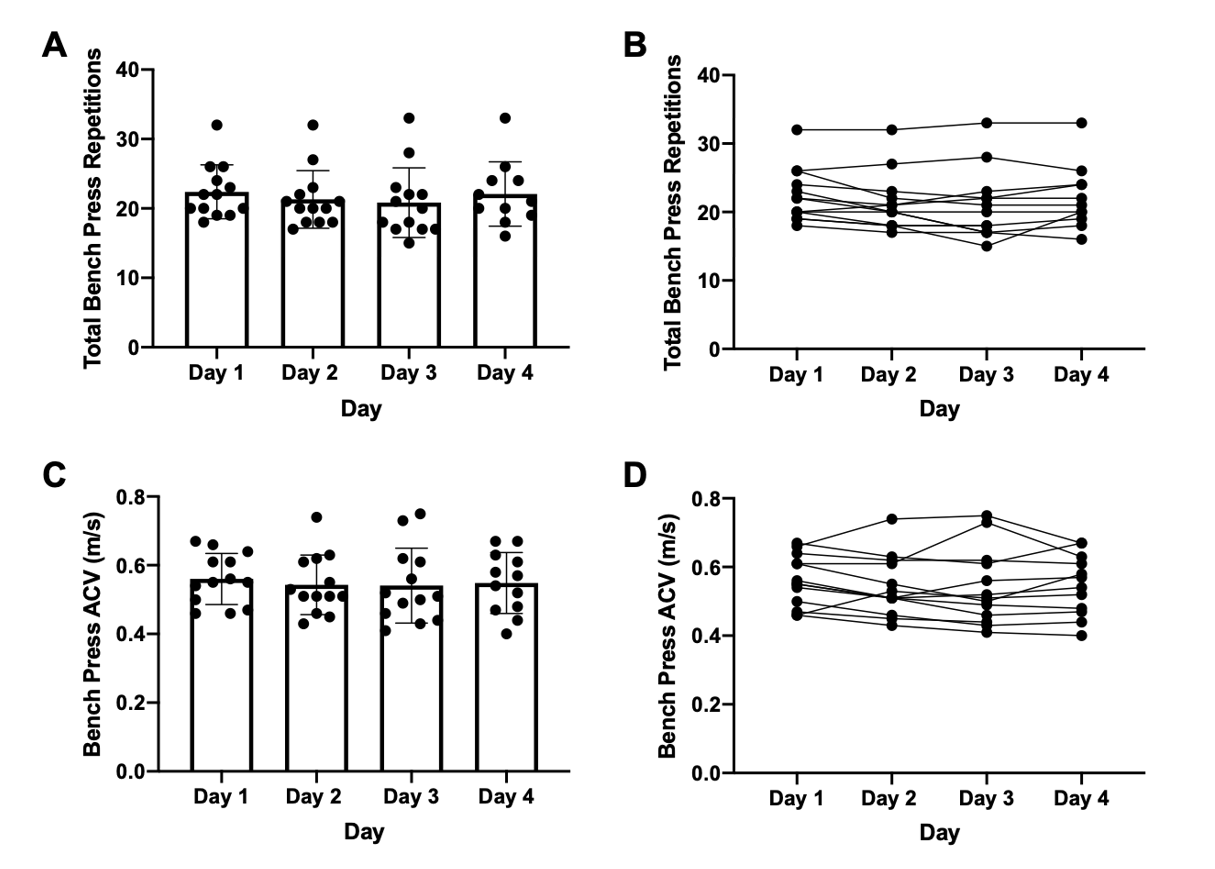
3.3. Squat performance
Mean (SD) total number of squat repetitions was 19.7 (4.3, n=11) on day 1 (Figure 2A), with no significant change between day 1 and day 3. On day 4, mean repetitions increased to 21.3 (6.9, p<0.001 versus day 3), with seven of n=9 remaining athletes (77.8%) increasing by two total repetitions (Figure 2B). Comparing day 3 and day 4 squat performance resulted in a repeated-measures ES (95% CI) of 1.8 (0.77-2.98), suggesting a large effect of the final training day on squat performance. Mean (range) ACV was 0.67 m/s (0.56-0.78m/s) on day 1 (Figure 2C), with some non-significant intra-individual variability across the four training days (Figure 2D).
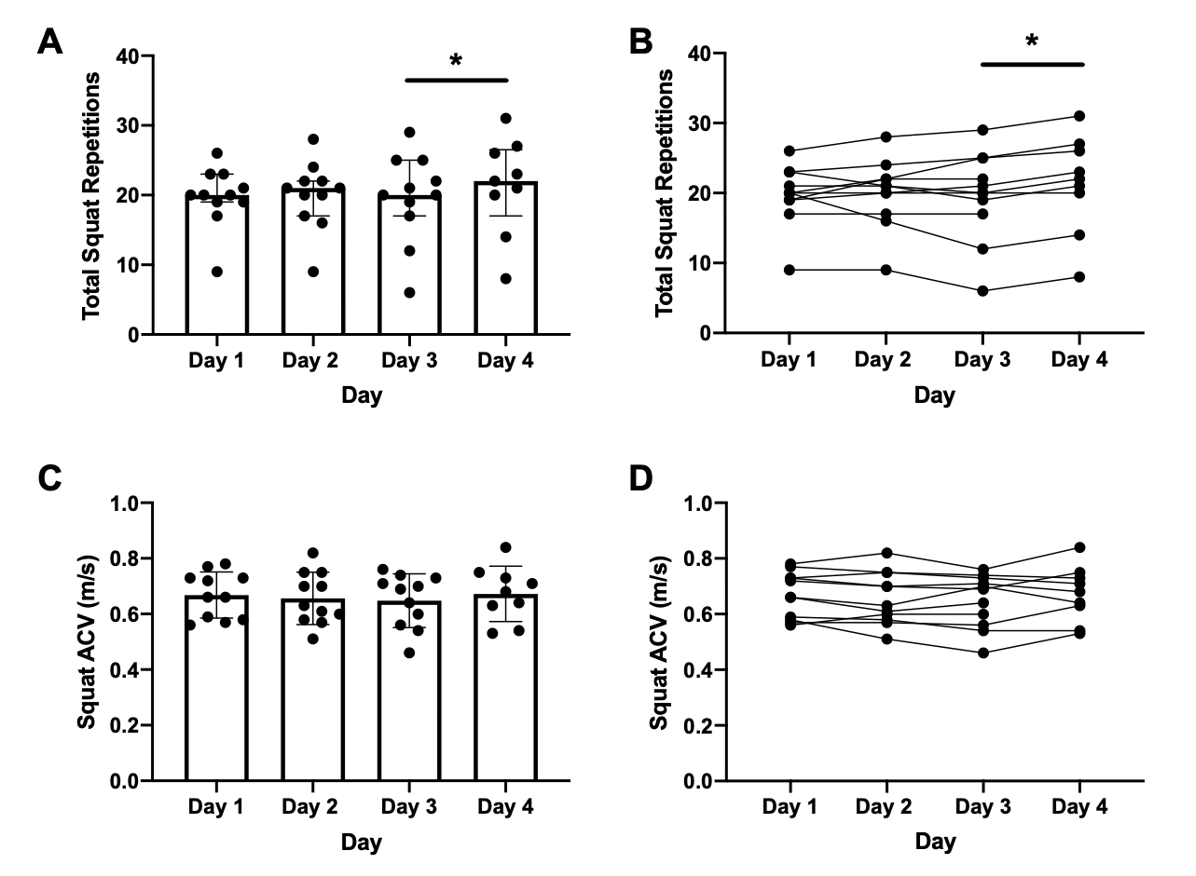
3.4. Changes in RPE and PRS over time
Mean (SD) session RPE was 7.7 (1.4) on day 1 (Figure 3A) and remained relatively stable across the four training days (Figure 3B). By comparison, mean (SD) PRS was 7.5 (2.6) on day 1, which decreased significantly by day 3 to 4.8 (2.8; p=0.001 vs day 1, p=0.01 vs day 2, Figure 3C). This resulted in a large ES (95% CI) of -2.4 (-3.9 to -1.4) on PRS as a result of three consecutive training days. PRS on day 4 increased slightly to 5.7 (2-10), which remained significantly lower than day 1 (p=0.03). The majority of individuals showing either stable or improved PRS on day 4 compared to day 3 (Figure 3D), suggesting that the cognitive effect of the final training day is associated with a relative subjective improvement in PRS.
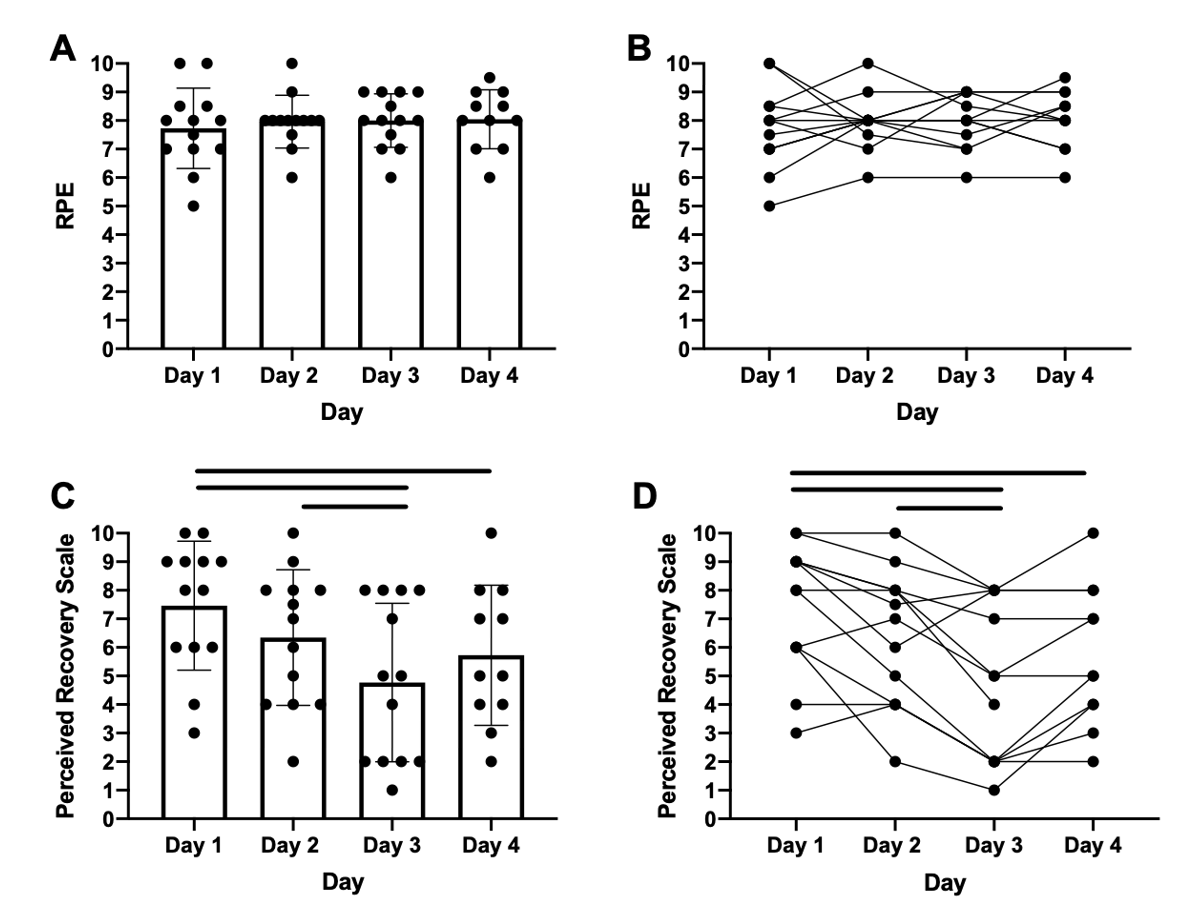
3.5. Repetition and ACV changes by set and training day
Normalizing repetitions and ACV to baseline (day 1 set 1), no significant correlation was seen between individual changes in ACV and per-set bench press repetitions on day 1 set 2 or any subsequent day (Figure 4A-D). No significant correlation was seen between individual changes in ACV and per-set squat repetitions on day 1 set 2 or day 2 (Figure 5A-B). By day 3 (Figure 5C), percent change in ACV was significantly correlated with percent change in squat repetitions, particularly on set 2 (R2=0.50, p=0.015), suggesting that increasing fatigue may result in better prediction of ACV changes and squat performance. However, this correlation was lost on day 4 (Figure 5C).
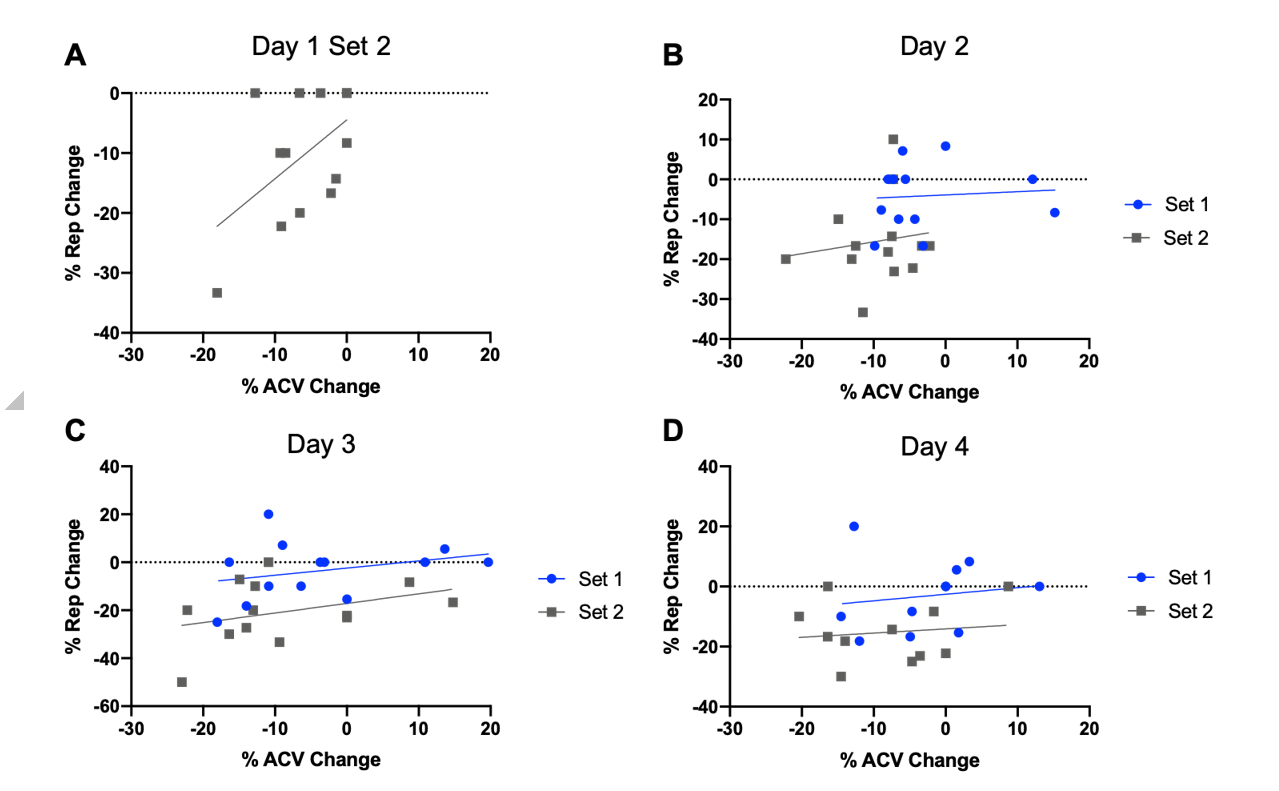
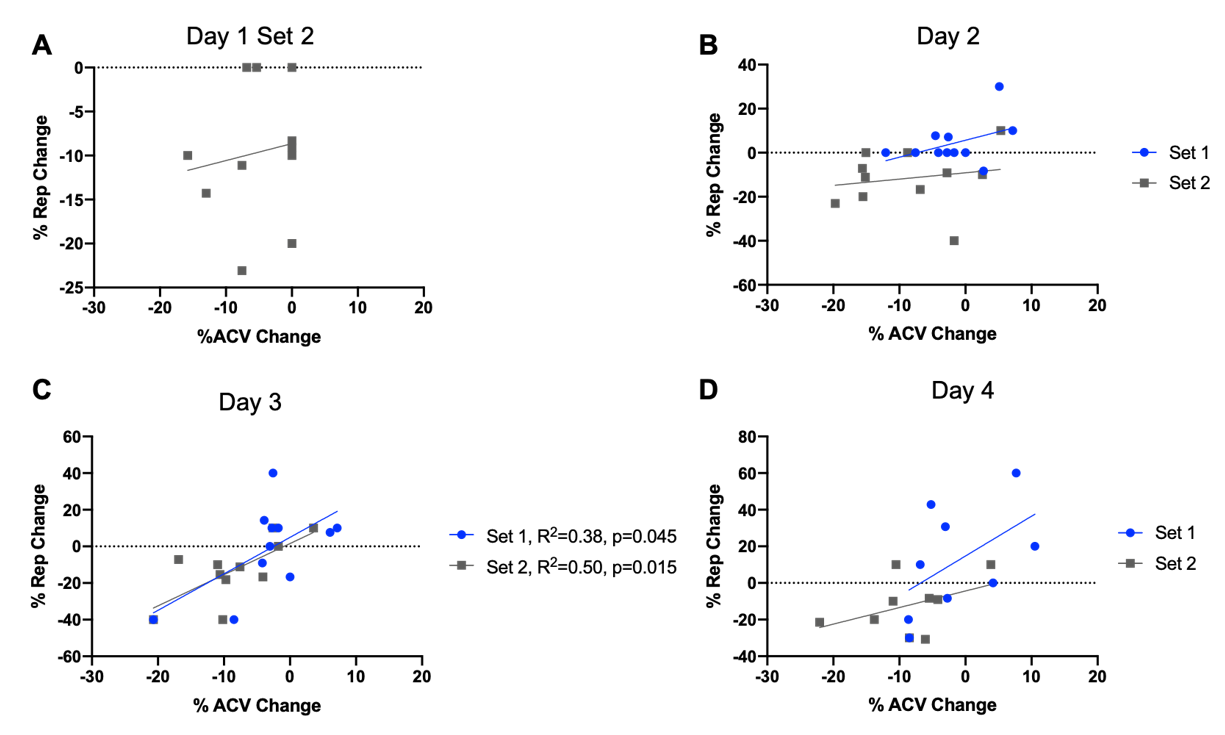
3.6. Final repetition and ACV changes by set and training day
Mean (SD) average final bench press repetition ACV was 0.16 m/s (0.04 m/s) on day 1 (Figure 6A), and despite some inter-individual variability, did not change significantly over time (Figure 6B). Mean (SD) average final squat repetition ACV was 0.34 m/s (0.07 m/s) on day 1 (Figure 6C), and remained relatively stable across days, despite changes in total repetitions from day 3 to day 4 (Figure 6D).
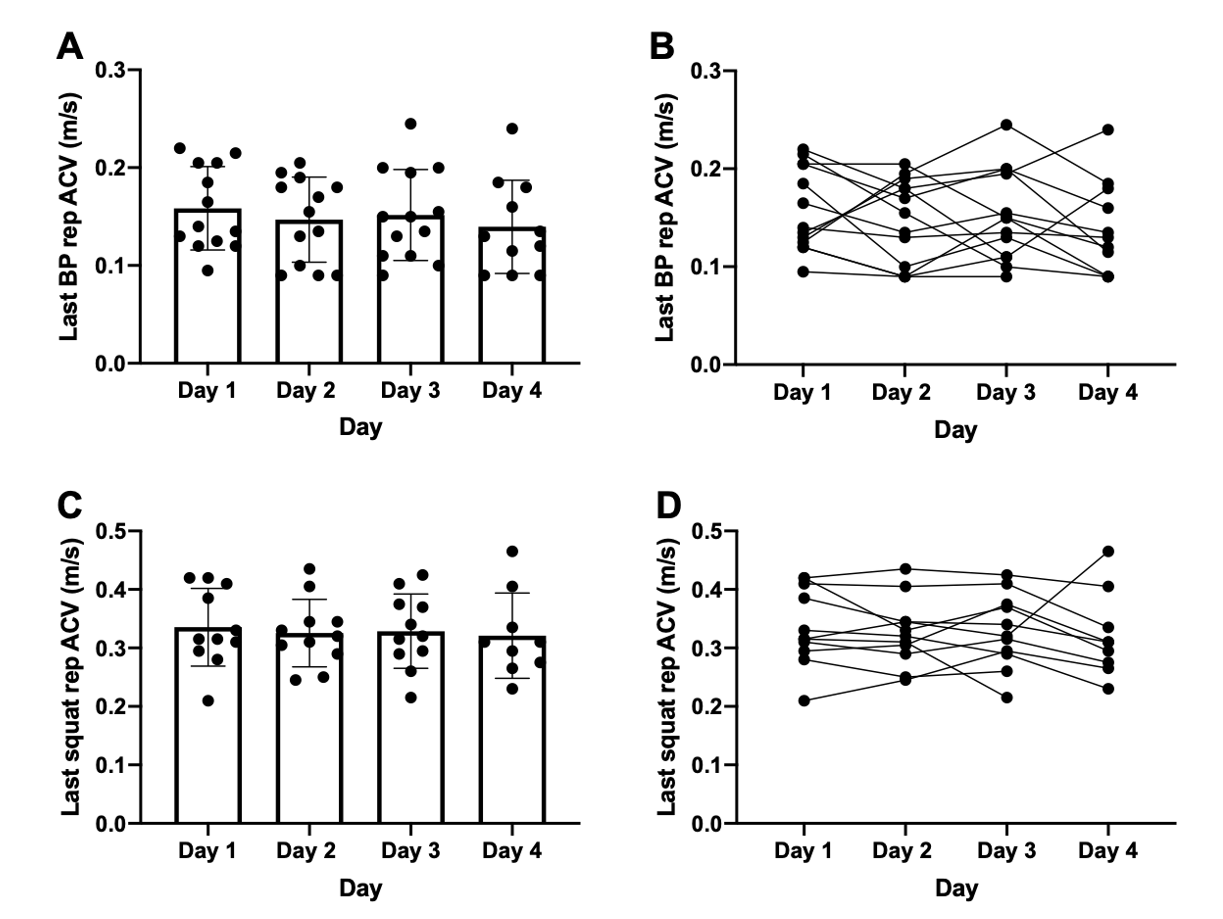
3.7. Changes in ACV and squat repetitions from day 3 to day 4
Normalizing day 4 repetitions and ACV to day 3 values (Figure 7), percent increase in average ACV (across both sets) on day 4 was significantly associated with the increase in total repetitions (R2=0.48, p=0.04; n=9). As the majority of participants increased by 2 repetitions on day 4 compared to day 3, this suggests that those athletes working closer to their 1RM (fewer total repetitions per set) produced the greatest relative increases in ACV in order to increase their total repetitions.
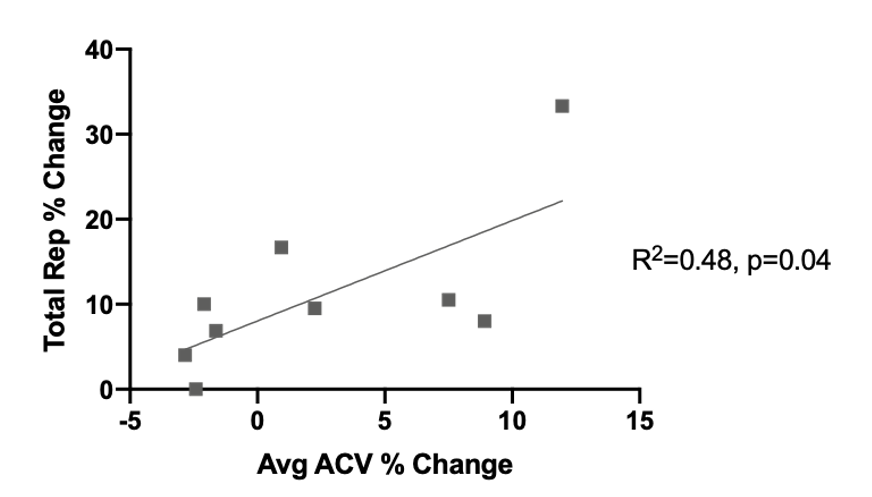
4. Discussion
To our knowledge, this is the first study to examine the recoverability of highly trained subjects over four consecutive training days when all sets were taken to an RPE of 9 to 9.5, which was confirmed via ACV testing on both the bench press and the squat. No significant decrease in total rep performance was seen across the four days for either the bench press or the squat, in fact, a significant increase in squat reps was seen on day 4 compared to day 3 (p=.04). Furthermore, no significant loss in ACV for a single repetition of the subject’s 10RM was seen for the bench or squat across the four consecutive training days.
Subjects did not train to failure, which may have been one of the reasons repetition performance was maintained [9]. It has been shown that trained subjects can recover from two to four sets per exercise within 48 hours, [1,2,5] and highly trained subjects may recover even faster than less trained subjects [6,9]. This study shows that highly trained subjects may be able to recover from four sets per muscle group in 24 hours when sets are not taken to complete momentary failure and are instead only taken to a 9 or 9.5 RPE.
It is possible that increased recoverability in highly trained subjects would allow for the ability to increase training frequency and training volume, which have both been related to increases in hypertrophic adaptations [14,15]. Training volume looks to be somewhat linearly related to muscle hypertrophy in more trained populations [15,18-20], and distributing volume over more days may potentially allow for further increases in productive training volumes in highly trained individuals. This thought process seems to be why this higher-frequency methodology is growing in popularity. However, subjects in this study did not significantly improve on their bench performance over the four days. Therefore, it may also be possible that the majority of subjects may not be positively adapting even though they were able to repeat their repetition performance on the current training frequency and volume. Longer-term studies in highly trained subjects that combine increased training frequency (>3 times per week) and volume (>15 sets per muscle group per week) are clearly warranted.
Recently, Belcher et al. found a significant decline at 24, 48, and 72 hours in the ACV for the squat after performing 4 sets to failure at 80% 1RM in highly trained subjects; however, no significant decline was seen for the bench press at 24, 48, or 72 hours after training [6]. Conversely, Moran-Navarro found no significant decrease when 3 and 6 sets were taken to a 5 RPE at 75% 1RM for the bench and the squat, but did see a decline in velocity at both 24 and 48 hours when three sets at 75% 1RM were taken to failure on bench press, as well as at 24 hours but not 48 hours for the squat [9].
The current results show no significant decline in a test rep ACV across four consecutive days of training for either the bench or the squat; however, subjects in the current study and the Belcher et al. study were likely more trained on both exercises compared to subjects in the Moran-Navarro study, [9] who had 1RMs of about 1.2 and 1.4 times body weight for the bench and the squat, respectively (compared to the current study population which had 10RMs of 1.03 times body weight). It is interesting to note that in the two previous studies subjects only performed these specific exercises, whereas in the current study subjects performed a full-body session each day. Therefore, when only two sets to a 9 to 9.5 RPE of bench and squat are performed inside of a full body workout no decline in ACV or repetition performance was seen across four consecutive training days in highly trained males.
Furthermore, perceived recovery in this sample was not predictive of ACV or rep performance suggesting that these highly trained subjects can likely maintain performance despite feeling less recovered. It may also be possible that repetition performance and ACV are not completely predictive of complete physiologic recovery although the majority of indirect markers of muscle damage were back to baseline in highly trained individuals within 24 hours after four sets to failure [6].
This study has multiple limitations. Nutrition was not controlled, but subjects were instructed to maintain their current nutrition and supplement plan. Ample protein-rich ad-libitum meals were provided throughout the study, and no subject decreased in body weight during the study. This study was performed in a novel gym environment with equipment that these subjects had not been using previously; however, all subjects had been bench pressing with a barbell and squatting utilizing their squat of choice for the previous 6 weeks. It may also have been possible that subjects were not able to repeatedly achieve a 9 or 9.5 RPE. This is highly unlikely given the training status of these individuals and the final bench press repetition ACV was 0.16 m/s (0.04 m/s), which is congruent with 1RM speeds in similar populations [39,40]. The average final squat repetition ACV was 0.34 m/s (0.07 m/s) a speed which is also in line with current research for repetitions at a 9 to 9.5 RPE [41]. However, seven of nine subjects did increase repetitions on the last day of training for the squat and this could have come from a change in form to complete those repetitions, excitement over it knowingly being the final training day, or perhaps they were not truly training to a 9 or 9.5 RPE on the previous sessions for the squat despite subjectively believing that they were and last repetition ACVs being in line with the literature for this RPE target.
Additionally, it is worth noting given the previous research showing that increased training status may increase recoverability that the three strongest individuals with an average 10RM bench press of 1.25 times bodyweight in this study never hit their day one set one numbers again on any subsequent set for the squat or the bench press. Another limitation of this study was that it only included highly trained males and thus may not apply to untrained subjects, though volume-equated consecutive day training has performed just as well as non-consecutive day training in untrained individuals for both strength and hypertrophy [42,43]. Additionally, these findings may not be applicable to females, however, to date recovery may potentially be faster in females than males [44-47], although the literature here is somewhat mixed [48,49].
5. Conclusions
For the majority of highly trained individuals, resistance-training performance may be maintained over four consecutive days of moderate volume full-body training at an RPE of 9-9.5, with decrements in perceived recovery not predictive of acute performance. The ability of subjects to recover from moderate volume non-failure training in 24 hours may allow these individuals to accumulate higher training frequencies and subsequently higher amounts of productive volume, but further applied research is necessary.
Author Contributions: Conceptualization, B.T.H, R.L., M.T.N., and T.R.W.; methodology, B.T.H, R.L., M.T.N., and T.R.W.; validation, B.T.H and T.R.W.; formal analysis, T.R.W.; investigation, B.T.H, R.L., and M.T.N.; resources, B.T.H and T.R.W; data curation, B.T.H and T.R.W.; writing—original draft preparation, B.T.H; writing—review and editing, R.L., M.T.N. and T.R.W.; visualization, T.R.W.; supervision, B.T.H and T.R.W.; project administration, B.T.H and T.R.W.; funding acquisition, B.T.H and T.R.W.. All authors have read and agreed to the published version of the manuscript.”
Funding: This research received no external funding.
Data Availability Statement: Deidentified data may be available from the authors upon reasonable request.
Acknowledgments: The authors would like to acknowledge Pete McKnight for his insightful comments during preparation of the manuscript, as well as all the lifters who made this study possible.
Conflicts of Interest: All the authors would like to disclose that they are coaches and writers within the fitness industry. Otherwise, the authors have no conflict of interest to disclose
References
1. Jones, E.J.; Bishop, P.A.; Richardson, M.T.; Smith, J.F. Stability of a practical measure of recovery from resistance training. J Strength Cond Res 2006, 20, 756-759, doi:10.1519/R-15554.1.
2. Korak, J.A.G., James M.; O'Neal, Eric K. Resistance Training Recovery: Considerations for Single vs. Multi-joint Movements and Upper vs. Lower Body Muscles. International Journal of Exercise Science 2015, 8, 85.
3. Bishop, P.A.; Jones, E.; Woods, A.K. Recovery from training: a brief review: brief review. J Strength Cond Res 2008, 22, 1015-1024, doi:10.1519/JSC.0b013e31816eb518.
4. Ferreira, D.V.; Gentil, P.; Ferreira-Junior, J.B.; Soares, S.R.S.; Brown, L.E.; Bottaro, M. Dissociated time course between peak torque and total work recovery following bench press training in resistance trained men. Physiol Behav 2017, 179, 143-147, doi:10.1016/j.physbeh.2017.06.001.
5. Miranda, H.; Maia, M.F.; Paz, G.A.; de Souza, J.; Simao, R.; Farias, D.A.; Willardson, J.M. Repetition Performance and Blood Lactate Responses Adopting Different Recovery Periods Between Training Sessions in Trained Men. J Strength Cond Res 2018, 32, 3340-3347, doi:10.1519/JSC.0000000000001840.
6. Belcher, D.J.; Sousa, C.A.; Carzoli, J.P.; Johnson, T.K.; Helms, E.; Visavadiya, N.P.; Zoeller, R.F.F.; Whitehurst, M.; Zourdos, M.C. Time Course of Recovery is Similar for the Back Squat, Bench Press, and Deadlift in Well-Trained Males. Appl Physiol Nutr Metab 2019, doi:10.1139/apnm-2019-0004.
7. McLester, J.R.; Bishop, P.A.; Smith, J.; Wyers, L.; Dale, B.; Kozusko, J.; Richardson, M.; Nevett, M.E.; Lomax, R. A series of studies--a practical protocol for testing muscular endurance recovery. J Strength Cond Res 2003, 17, 259-273.
8. de Camargo, J.B.B.; Braz, T.V.; Batista, D.R.; Germano, M.D.; Brigatto, F.A.; Lopes, C.R. Dissociated Time Course of Indirect Markers of Muscle Damage Recovery Between Single-Joint and Multi-joint Exercises in Resistance-Trained Men. J Strength Cond Res 2020, Publish Ahead of Print, doi:10.1519/JSC.0000000000003811.
9. Moran-Navarro, R.; Perez, C.E.; Mora-Rodriguez, R.; de la Cruz-Sanchez, E.; Gonzalez-Badillo, J.J.; Sanchez-Medina, L.; Pallares, J.G. Time course of recovery following resistance training leading or not to failure. Eur J Appl Physiol 2017, 117, 2387-2399, doi:10.1007/s00421-017-3725-7.
10. Pareja-Blanco, F.; Rodriguez-Rosell, D.; Aagaard, P.; Sanchez-Medina, L.; Ribas-Serna, J.; Mora-Custodio, R.; Otero-Esquina, C.; Yanez-Garcia, J.M.; Gonzalez-Badillo, J.J. Time Course of Recovery From Resistance Exercise With Different Set Configurations. J Strength Cond Res 2020, 34, 2867-2876, doi:10.1519/JSC.0000000000002756.
11. Soares, S.; Ferreira-Junior, J.B.; Pereira, M.C.; Cleto, V.A.; Castanheira, R.P.; Cadore, E.L.; Brown, L.E.; Gentil, P.; Bemben, M.G.; Bottaro, M. Dissociated Time Course of Muscle Damage Recovery Between Single- and Multi-Joint Exercises in Highly Resistance-Trained Men. J Strength Cond Res 2015, 29, 2594-2599, doi:10.1519/JSC.0000000000000899.
12. Wallace, W.; Ugrinowitsch, C.; Stefan, M.; Rauch, J.; Barakat, C.; Shields, K.; Barninger, A.; Barroso, R.; De Souza, E.O. Repeated Bouts of Advanced Strength Training Techniques: Effects on Volume Load, Metabolic Responses, and Muscle Activation in Trained Individuals. Sports (Basel) 2019, 7, doi:10.3390/sports7010014.
13. Paz, G.A.; de Freitas Maia, M.; de Araújo Farias, D.; Miranda, H.; Willardson, J.M. Muscle activation and volume load performance of paired resistance training bouts with differing inter-session recovery periods. Science & Sports 2021, 36, 152-159, doi:https://doi.org/10.1016/j.scispo.2020.02.011.
14. Schoenfeld, B.J.; Ogborn, D.; Krieger, J.W. Effects of Resistance Training Frequency on Measures of Muscle Hypertrophy: A Systematic Review and Meta-Analysis. Sports Med 2016, 46, 1689-1697, doi:10.1007/s40279-016-0543-8.
15. Schoenfeld, B.J.; Ogborn, D.; Krieger, J.W. Dose-response relationship between weekly resistance training volume and increases in muscle mass: A systematic review and meta-analysis. J Sports Sci 2016, 1-10, doi:10.1080/02640414.2016.1210197.
16. Zaroni, R.S.; Brigatto, F.A.; Schoenfeld, B.J.; Braz, T.V.; Benvenutti, J.C.; Germano, M.D.; Marchetti, P.H.; Aoki, M.S.; Lopes, C.R. High Resistance-Training Frequency Enhances Muscle Thickness in Resistance-Trained Men. J Strength Cond Res 2019, 33 Suppl 1, S140-S151, doi:10.1519/JSC.0000000000002643.
17. Schoenfeld, B.J.; Grgic, J.; Krieger, J. How many times per week should a muscle be trained to maximize muscle hypertrophy? A systematic review and meta-analysis of studies examining the effects of resistance training frequency. J Sports Sci 2019, 37, 1286-1295, doi:10.1080/02640414.2018.1555906.
18. Haun, C.T.; Vann, C.G.; Mobley, C.B.; Roberson, P.A.; Osburn, S.C.; Holmes, H.M.; Mumford, P.M.; Romero, M.A.; Young, K.C.; Moon, J.R.; et al. Effects of Graded Whey Supplementation During Extreme-Volume Resistance Training. Front Nutr 2018, 5, 84, doi:10.3389/fnut.2018.00084.
19. Schoenfeld, B.J.; Contreras, B.; Krieger, J.; Grgic, J.; Delcastillo, K.; Belliard, R.; Alto, A. Resistance Training Volume Enhances Muscle Hypertrophy. Medicine and science in sports and exercise 2018, doi:10.1249/MSS.0000000000001764.
20. Radaelli, R.; Fleck, S.J.; Leite, T.; Leite, R.D.; Pinto, R.S.; Fernandes, L.; Simao, R. Dose-response of 1, 3, and 5 sets of resistance exercise on strength, local muscular endurance, and hypertrophy. J Strength Cond Res 2015, 29, 1349-1358, doi:10.1519/JSC.0000000000000758.
21. Amirthalingam, T.; Mavros, Y.; Wilson, G.C.; Clarke, J.L.; Mitchell, L.; Hackett, D.A. Effects of a Modified German Volume Training Program on Muscular Hypertrophy and Strength. J Strength Cond Res 2016, doi:10.1519/JSC.0000000000001747.
22. Heaselgrave, S.R.; Blacker, J.; Smeuninx, B.; McKendry, J.; Breen, L. Dose-Response Relationship of Weekly Resistance-Training Volume and Frequency on Muscular Adaptations in Trained Men. Int J Sports Physiol Perform 2019, 14, 360-368, doi:10.1123/ijspp.2018-0427.
23. Cuthbert, M.; Haff, G.G.; Arent, S.M.; Ripley, N.; McMahon, J.J.; Evans, M.; Comfort, P. Effects of Variations in Resistance Training Frequency on Strength Development in Well-Trained Populations and Implications for In-Season Athlete Training: A Systematic Review and Meta-analysis. Sports Med 2021, doi:10.1007/s40279-021-01460-7.
24. Ralston, G.W.; Kilgore, L.; Wyatt, F.B.; Baker, J.S. The Effect of Weekly Set Volume on Strength Gain: A Meta-Analysis. Sports Med 2017, 47, 2585-2601, doi:10.1007/s40279-017-0762-7.
25. Vieira, A.F.; Umpierre, D.; Teodoro, J.L.; Lisboa, S.C.; Baroni, B.M.; Izquierdo, M.; Cadore, E.L. Effects of Resistance Training Performed to Failure or Not to Failure on Muscle Strength, Hypertrophy, and Power Output: A Systematic Review With Meta-Analysis. J Strength Cond Res 2021, 35, 1165-1175, doi:10.1519/JSC.0000000000003936.
26. Helms, E.R.; Storey, A.; Cross, M.R.; Brown, S.R.; Lenetsky, S.; Ramsay, H.; Dillen, C.; Zourdos, M.C. RPE and Velocity Relationships for the Back Squat, Bench Press, and Deadlift in Powerlifters. J Strength Cond Res 2017, 31, 292-297, doi:10.1519/JSC.0000000000001517.
27. Laurent, C.M.; Green, J.M.; Bishop, P.A.; Sjokvist, J.; Schumacker, R.E.; Richardson, M.T.; Curtner-Smith, M. A practical approach to monitoring recovery: development of a perceived recovery status scale. J Strength Cond Res 2011, 25, 620-628, doi:10.1519/JSC.0b013e3181c69ec6.
28. Arney, B.E.; Glover, R.; Fusco, A.; Cortis, C.; de Koning, J.J.; van Erp, T.; Jaime, S.; Mikat, R.P.; Porcari, J.P.; Foster, C. Comparison of RPE (Rating of Perceived Exertion) Scales for Session RPE. Int J Sports Physiol Perform 2019, 14, 994-996, doi:10.1123/ijspp.2018-0637.
29. Orange, S.T.; Metcalfe, J.W.; Marshall, P.; Vince, R.V.; Madden, L.A.; Liefeith, A. Test-Retest Reliability of a Commercial Linear Position Transducer (GymAware PowerTool) to Measure Velocity and Power in the Back Squat and Bench Press. J Strength Cond Res 2018, doi:10.1519/JSC.0000000000002715.
30. Baranauskas, M.N.; Johnson, K.E.; Juvancic-Heltzel, J.A.; Kappler, R.M.; Richardson, L.; Jamieson, S.; Otterstetter, R. Seven-site versus three-site method of body composition using BodyMetrix ultrasound compared to dual-energy X-ray absorptiometry. Clin Physiol Funct Imaging 2017, 37, 317-321, doi:10.1111/cpf.12307.
31. Johnson, K.E.; Miller, B.; Gibson, A.L.; McLain, T.A.; Juvancic-Heltzel, J.A.; Kappler, R.M.; Otterstetter, R. A comparison of dual-energy X-ray absorptiometry, air displacement plethysmography and A-mode ultrasound to assess body composition in college-age adults. Clin Physiol Funct Imaging 2017, 37, 646-654, doi:10.1111/cpf.12351.
32. Schoenfeld, B.J.; Aragon, A.A.; Moon, J.; Krieger, J.W.; Tiryaki-Sonmez, G. Comparison of amplitude-mode ultrasound versus air displacement plethysmography for assessing body composition changes following participation in a structured weight-loss programme in women. Clin Physiol Funct Imaging 2017, 37, 663-668, doi:10.1111/cpf.12355.
33. Wagner, D.R.; Cain, D.L.; Clark, N.W. Validity and Reliability of A-Mode Ultrasound for Body Composition Assessment of NCAA Division I Athletes. PloS one 2016, 11, e0153146, doi:10.1371/journal.pone.0153146.
34. Hyde, P.N.; Kendall, K.L.; Fairman, C.M.; Coker, N.A.; Yarbrough, M.E.; Rossi, S.J. Use of B-Mode Ultrasound as a Body Fat Estimate in Collegiate Football Players. J Strength Cond Res 2016, 30, 3525-3530, doi:10.1519/JSC.0000000000001447.
35. Smith-Ryan, A.E.; Fultz, S.N.; Melvin, M.N.; Wingfield, H.L.; Woessner, M.N. Reproducibility and validity of A-mode ultrasound for body composition measurement and classification in overweight and obese men and women. PloS one 2014, 9, e91750, doi:10.1371/journal.pone.0091750.
36. Kouri, E.M.; Pope, H.G., Jr.; Katz, D.L.; Oliva, P. Fat-free mass index in users and nonusers of anabolic-androgenic steroids. Clin J Sport Med 1995, 5, 223-228.
37. Morris, S.B.; DeShon, R.P. Combining effect size estimates in meta-analysis with repeated measures and independent-groups designs. Psychol Methods 2002, 7, 105-125, doi:10.1037/1082-989x.7.1.105.
38. Lenhard, W.L., A. Calculation of Effect Sizes. Psychometrica, doi:10.13140/RG.2.2.17823.92329.
39. Ormsbee, M.J.; Carzoli, J.P.; Klemp, A.; Allman, B.R.; Zourdos, M.C.; Kim, J.S.; Panton, L.B. Efficacy of the Repetitions in Reserve-Based Rating of Perceived Exertion for the Bench Press in Experienced and Novice Benchers. J Strength Cond Res 2019, 33, 337-345, doi:10.1519/JSC.0000000000001901.
40. Fahs, C.A.; Blumkaitis, J.C.; Rossow, L.M. Factors Related to Average Concentric Velocity of Four Barbell Exercises at Various Loads. J Strength Cond Res 2019, 33, 597-605, doi:10.1519/JSC.0000000000003043.
41. Zourdos, M.C.; Klemp, A.; Dolan, C.; Quiles, J.M.; Schau, K.A.; Jo, E.; Helms, E.; Esgro, B.; Duncan, S.; Garcia Merino, S.; et al. Novel Resistance Training-Specific Rating of Perceived Exertion Scale Measuring Repetitions in Reserve. J Strength Cond Res 2016, 30, 267-275, doi:10.1519/JSC.0000000000001049.
42. Yang, Y.; Bay, P.B.; Wang, Y.R.; Huang, J.; Teo, H.W.J.; Goh, J. Effects of Consecutive Versus Non-consecutive Days of Resistance Training on Strength, Body Composition, and Red Blood Cells. Frontiers in physiology 2018, 9, 725, doi:10.3389/fphys.2018.00725.
43. da Silva Carvalho, A.D.; Rodrigues Santos, J.A. Nonconsecutive versus consecutive-day resistance training in recreationally trained subjects. J Sports Med Phys Fitness 2018, 58, 233-240, doi:10.23736/S0022-4707.16.06660-3.
44. Judge, L.W.; Burke, J.R. The effect of recovery time on strength performance following a high-intensity bench press workout in males and females. Int J Sports Physiol Perform 2010, 5, 184-196, doi:10.1123/ijspp.5.2.184.
45. Amdi, C.H.; Cleather, D.J.; Tallent, J. Impact of Training Protocols on Lifting Velocity Recovery in Resistance Trained Males and Females. Sports (Basel) 2021, 9, doi:10.3390/sports9110157.
46. Hakkinen, K. Neuromuscular fatigue in males and females during strenuous heavy resistance loading. Electromyogr Clin Neurophysiol 1994, 34, 205-214.
47. Amorim, M.Z.; Machado, M.; Hackney, A.C.; de Oliveira, W.; Luz, C.P.; Pereira, R. Sex differences in serum CK activity but not in glomerular filtration rate after resistance exercise: is there a sex dependent renal adaptative response? J Physiol Sci 2014, 64, 31-36, doi:10.1007/s12576-013-0287-2.
48. Benini, R.; Nunes, P.R.P.; Orsatti, C.L.; Portari, G.V.; Orsatti, F.L. Influence of sex on cytokines, heat shock protein and oxidative stress markers in response to an acute total body resistance exercise protocol. J Exerc Sci Fit 2015, 13, 1-7, doi:10.1016/j.jesf.2014.10.002.
49. Davies, R.W.; Carson, B.P.; Jakeman, P.M. Sex Differences in the Temporal Recovery of Neuromuscular Function Following Resistance Training in Resistance Trained Men and Women 18 to 35 Years. Frontiers in physiology 2018, 9, 1480, doi:10.3389/fphys.2018.01480.

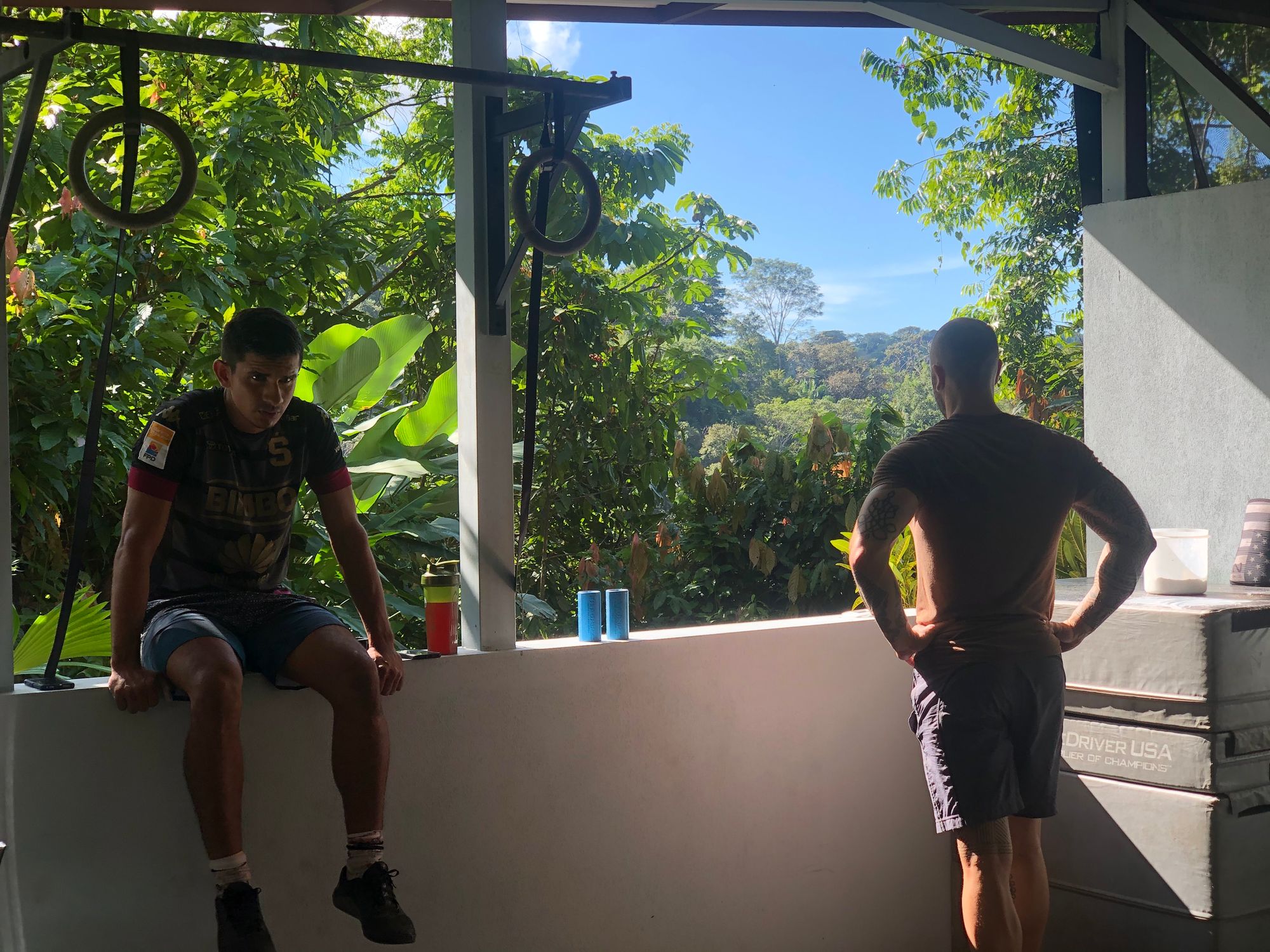




Related Content
2024/25 Programming Template
Nov 01, 2024
Can Tendons Hypertrophy In Trained Individuals?
Sep 29, 2024
Do High Step Counts Blunt Muscle Hypertrophy?
Aug 16, 2024